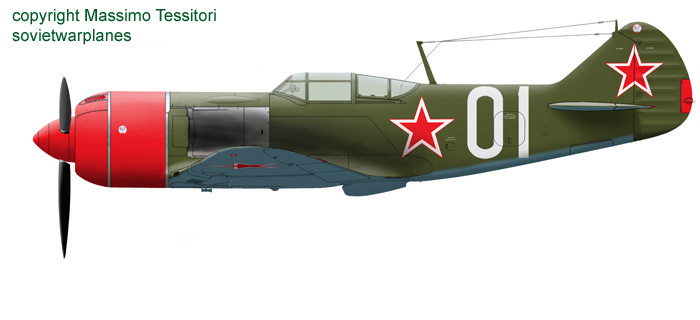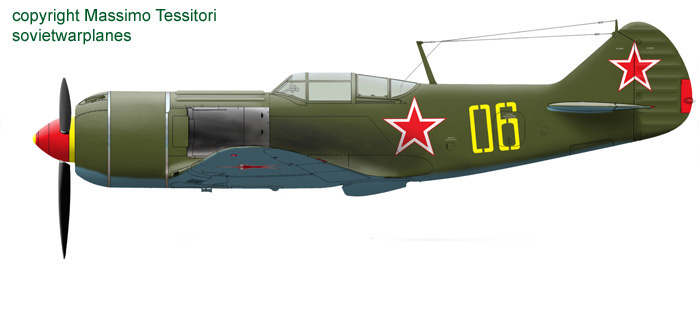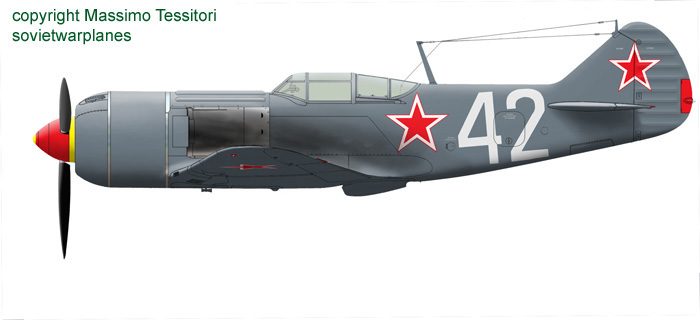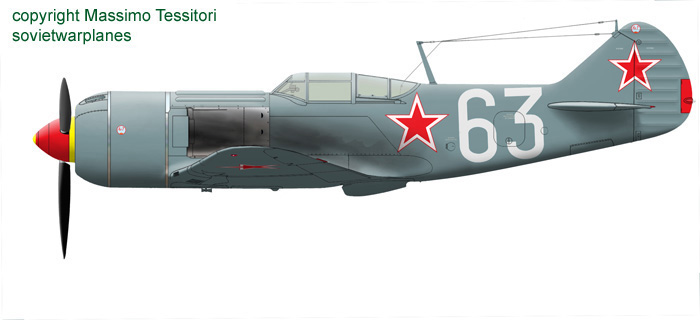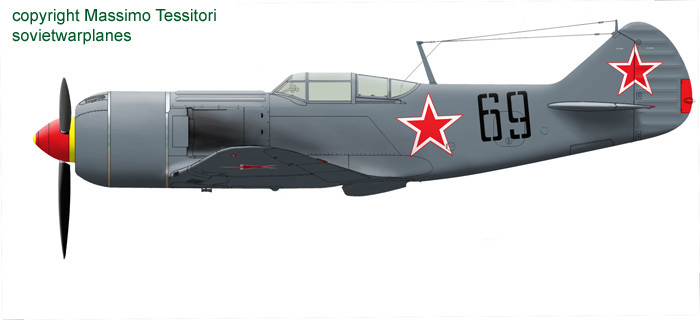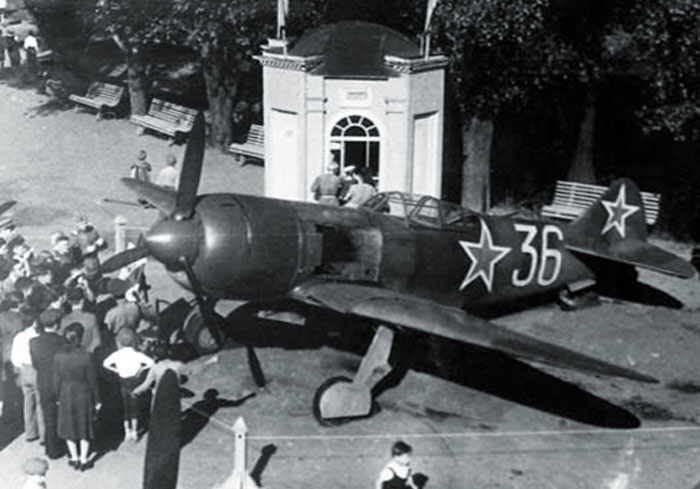01 of 176 giap
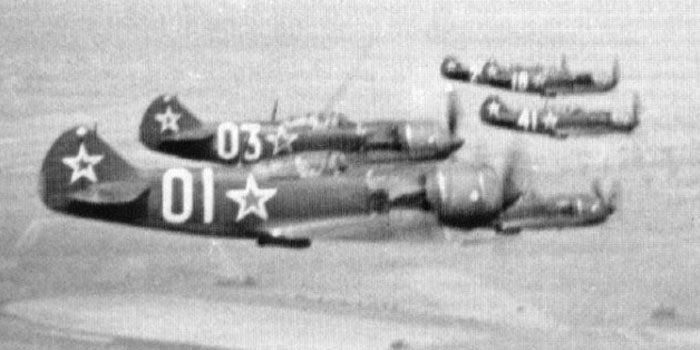
According to La-7of Milos Vestsik, MBI, these planes were of 176 giap, photographed by the frontline reporter Aleksander Dmitriyev on 10-20 April 1945 during the Berlin Operation. According to the caption, these six planes were assembled just for the session.
There is something strange on these planes: they have an uniformly dark uppersurface instead of the grey/grey camouflage; this color could be dark green AMT-4 or dark grey AMT-12. All the cowlings look of a different color, probably red. There is not resemblance with other known planes of 176 giap, that had grey/grey camouflage, oblique white caps on the tail and red noses with red triangles on the sides, and were more beautiful.
On the whole, they give the idea of planes repainted after the end of the war.
Image from La-7of Milos Vestsik, MBI.
An interpretation of the look of the planes of the photo before.
06 of 176 giap

A line of planes, probably of 176 giap, show that they were fully repainted in a scarcely standardized way, that conforms to two main standards: green (or dark grey?) uppersurface with light blue undersurface, or overall grey.
These planes are a late version armed with three B-20 guns, recognizable for their long and uniform fairings on the upper part of the nose.
.
A profile of plane 06, armed with 3 B-20 guns.
The upper and side surfaces were dark, probably dark green AMT-4; they could alse be interpreted as dark grey AMT-12; anyway, while the use of green uppersurfaces on Soviet planes after the war is demonstrated, the use of dark grey is still hypothetical.
The look of the spinner is hypothetical, it could also be interpreted as dark green, with light tip and other areas.

Another part of the line of the previous imag shows planes with uniform grey livery, including both upper and undersurfaces.
Note that the shade of grey is different for the planes: the closer one looks darker nd could be painted with AMT-11 blue grey; the color of the second plane is clearly lighter.but, if the photo was taken in late 1945, it's unlikely that A-36g was already available, so it has to be another paint, possibly of German origin.
Despite of the only partial visibility of the planes, these liveries are of great interest so I have tried a reconstruction of them. Everything not visible on the photos was guessed.
La-7 n.42, armed with 3 B-20 guns, shows uniform grey livery, including both upper and undersurfaces.
The plane is ony partially visible on the photo; all what is not visible was guessed, including the number.
The shade of grey is different for each plane; n.42 could be painted with AMT-11 blue grey.
Plane 63 was a 3-guns La-7, with what seems an uniform light grey or light blue-grey livery.
The plane is ony partially visible on the photo; all what is not visible was guessed, including the number..
If the photo was taken in late 1945, it's unlikely that Soviet light blue-grey A-36g was already available, so it has to be another paint, possibly of German origin.
Black 69 on show
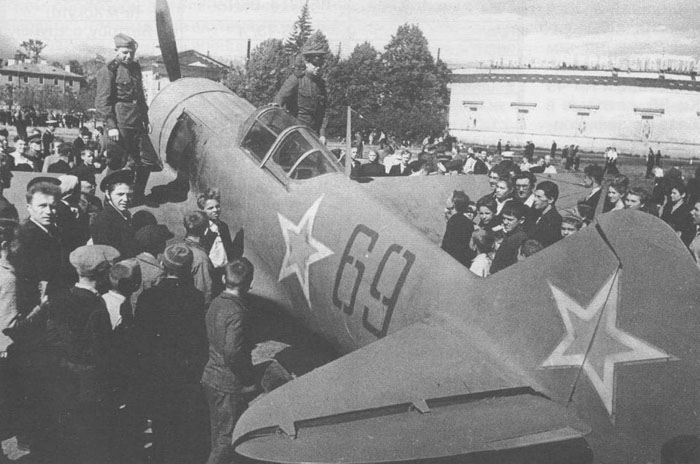
Another plane 'black 69' of unknown unit is shown during a public exposition, probably in Leningrad.
This plane looks to wear an uniform grey livery.
Uniform grey fighters became a standard after the introduction of the paints AMT-16, AGT-16, A-36m, A-36g in 1947.
The fonts of the bort number seem similar to that of plane 'yellow 06', so there is the vague possibility that this plane is of 176 giap too.
So, the spinner was drawn in the same way.
This plane looks to wear an uniform grey livery.
Uniform grey fighters became a standard after the introduction of the paints AMT-16, AGT-16, A-36m, A-36g in 1947.
Not knowing when the plane was exposed, the hypothized overall color is AMT-11.
Plane with Guards emblem on the tail

Interesting photo of 2-guns La-7s of an unidentified unit. (866 iap?)
The most interesting characteristic is that the national emblem on the tail is replaced by a simplified Guards emblem overposed to an oblique band, probably white-red-white. Probably this was a regimental emblem, worn on all the planes of the unit. The tail of the second plane, although faded on the photo, seems to confirm this.
A very similar emblem was seen on the tail of a Yak-9 of 866 iap.
Note that the band on the trim tab is different, perhaps the trim was replaced with the one of another plane, or preserved a previous version of the regimental mark.
The plane seems repainted with a solid dark gloss color on its uppersurfaces, green or dark grey. This suggests that the photo could have been shot after the war's end, although some sources date it during the winter 1944/45.
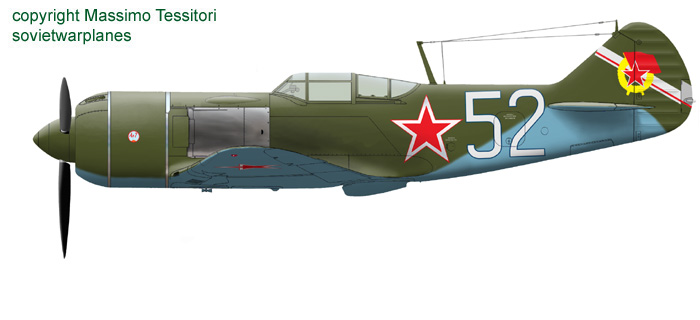
Reconstruction of the look of a plane of this unit.
The bort number is a guess
A plane exposed in the park of the CDSA (Central House of Soviet Army) in Moscow after the war.
To see more, go to this page
14 on a movie of 1946
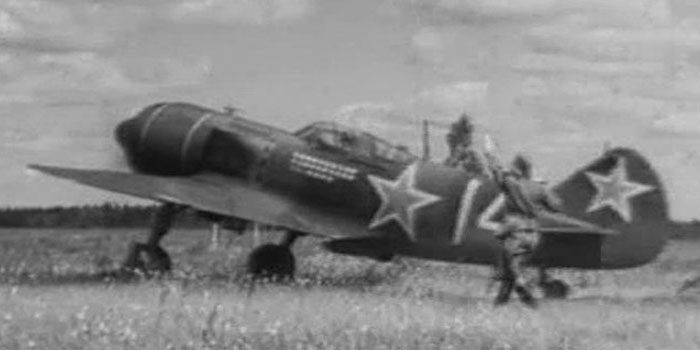
This plane 14 was employed for a movie of 1946.
http://forum.guns.ru/forummessage/85/240819-217.htmll movie
It looks a 3-guns La-7 built in z.381. The painting looks as a standard grey/grey camouflage, probably the only interesting thing is the roster of victory starlets, certainly fictional.
La-7 of unidentified unit


Two images of another plane of an unidentified giap after the war.
It looks painted with AMT.11 grey uppersurfaces and light blue undersurfaces. The light blue painting looks extended to the landing gear bay too.
The red star wih white outline and center on the spinner, and the Guards emblem on the cowling are noteworthy.
Note also the unusual painting of the tips of the propeller.
63 of 63 giap, with Maresyev

Images of the visit that the former gpw ace Alexey Maresyev made to the 63 GIAP, where he fought during the war, in 1946 .
Maresyev lost both his legs during the war, but continued to fly and fight successfully with prothesis. He was dismissed from the VVS after the war's end, but continued to fly for some years.
http://airaces.narod.ru/all6/maresyev.htm
The plane is a 3-guns La-7 built in Z.381.
This photo is the only one of the sequence to show the number of the plane on its fin, a small and angular 63.
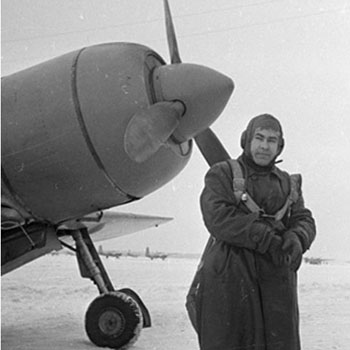
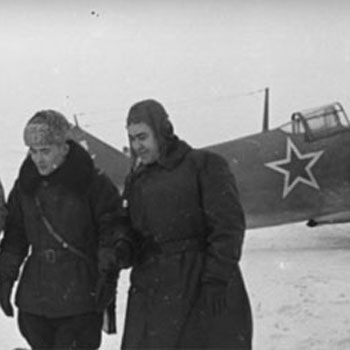
The plane looks fully repainted after the war, probably medium grey AMT-11 on the uppersurfaces and light blue AMT-7 on the undersurfaces.
Even the size of the stars seem not the original one of Z.381.
No any number seems painted on the fuselage sides.
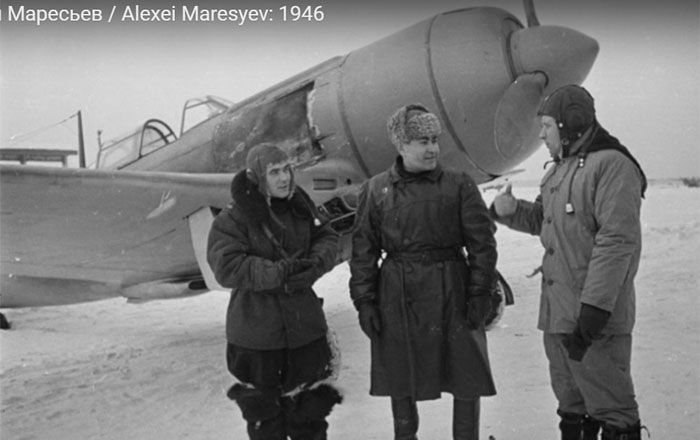
A prominent characteristic of these planes is the cowling and spinner painted with a glossy uniform color, still unidentified. It's much lighter than the red stars. Yellow, orange or blue could be hypothyzed. As an alternative, it could be a complete repainting of the cowling and spinner with a slightly lighter shade of grey.
We see well the typical linear bulges on the nose that characterized 3-guns La-7s
Note how soft is the division between medium grey and light blue on the rear of the fuselage.
https://www.youtube.com/watch?v=ARhFH_w0D98
https://russiainphoto.ru/search/
http://scalemodels.ru/modules/forum/viewtopic_t_14994_start_20.html
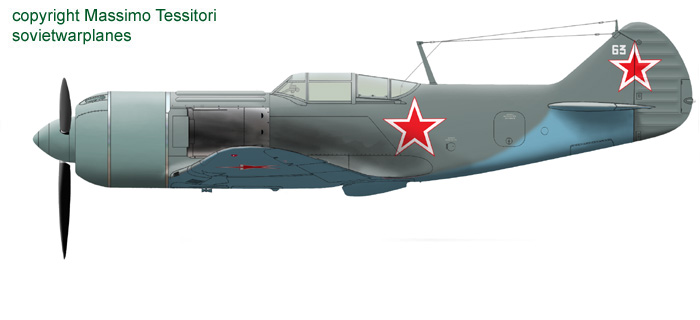
A profile of plane 63, supposed of 63 giap, 1946.
In absence of different informations, the uniform painting of the nose was prudently assumed as a grey repainting.
